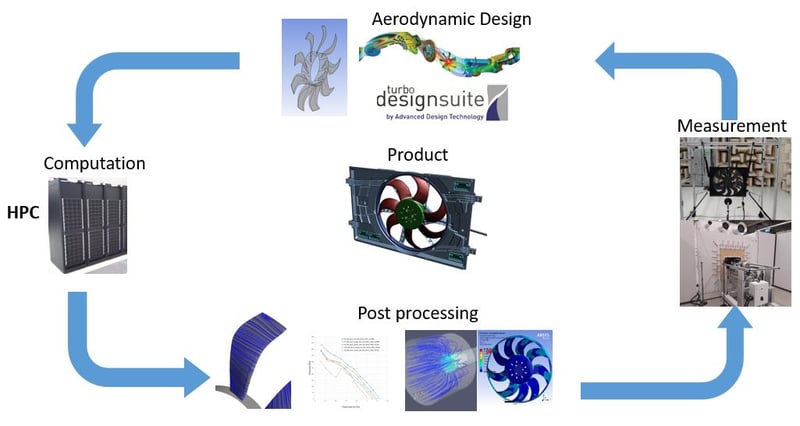Hanon Systems provides complete solutions for automotive cooling systems, including electronic cooling fans (eCF’s) for power classes starting from 300W and reaching up to 1.5 kW. This paper, presented during the FAN 2022 Conference, focuses on the development of electronic cooling fans in the “high power” class.
 Figure 1: Typical development process of a fan at Hanon Systems in Bad Homburg.
Figure 1: Typical development process of a fan at Hanon Systems in Bad Homburg.
We present a methodology in which the important know-how of an existing high-performing design is captured by using an inverse design method to reverse engineer the existing blade and hence recover the existing loading of the fan blade. Then use this loading as a basis for the design optimization of the automotive cooling fan that meets the new challenging requirements.
In this paper, we want to show how this approach was implemented as well as the benefits gained on performance, acoustics and time-to-delivery.
In order to combine both existing methods, a complex aerodynamic design process involving reverse engineering, CFD simulations and experimental validation has been set up. Starting from the loading obtained from reverse engineering of an existing design, a process was followed in which the spanwise work and streamwise loading were varied systematically by using the inverse design method and the resulting performance evaluated by using a previously validated CFD simulation set up.
Parallel structural and modal analysis simulations were performed to ensure the structural integrity of the design during operation. Performance measurements have confirmed the CFD simulations results and acoustic measurements showed an excellent behavior.
.jpg?width=400&name=ISO%205801%20Airflow%20test%20stand%20with%20external%20drive%20at%20Hanon%20Systems%20in%20Bad%20Homburg%20(serial%20sample%20is%20shown).jpg) Figure 2: a) ISO 5801 Airflow test stand with external drive at Hanon Systems in Bad Homburg (serial sample is shown)
Figure 2: a) ISO 5801 Airflow test stand with external drive at Hanon Systems in Bad Homburg (serial sample is shown)
.jpg?width=400&name=Semi-anechoic%20room%20with%20sample%20fan%20and%20two%20microphones%20(Hanon%20Systems%2c%20Kerpen%2c%20Germany).jpg)
Figure 2: b) Semi-anechoic room with sample fan and two microphones (Hanon Systems, Kerpen, Germany)
This study has shown how efficient design features available in legacy designs can be integrated in new designs by using 3D inverse design method and the reverse engineering functionality available in commercial 3D inverse design code TURBOdesign1.
The reverse engineering process helps to capture the main know-how in the design of previous high-performing fans in terms of main inputs of inverse design method such as spanwise work, streamwise loading and stacking conditions.
Starting from these previous input specifications, the inverse design method can be quickly used to optimize fans with new specifications in terms of diameter, flow rate, pressure rise or torque. It is also shown that the new fan design shows improved efficiency and improved acoustic.
Mehrdad Zangeneh
Mehrdad Zangeneh is Founder and Managing Director of Advanced Design Technology and professor of Thermofluids at University College London.
View All Articles



Share This Post